Supporting guidance for Moorland Management
This is an old version of the page
This is an old version of the page.
Date published: 30 March, 2015
Date superseded: 17 December, 2015
The management of our moorland areas has changed over centuries of farming and deer management. These moorland areas are a distinct and important part of our natural heritage.
Domestic livestock and deer have grazed our moorlands and shaped and altered our upland habitats. This option seeks to establish the good condition of these habitats as a management priority and encourage practices that restore, maintain or enhance them.
Moorlands are a mosaic of different habitats determined by soil, altitude, drainage and, in some cases, previous grazing. Theses habitats have different stock-carrying capacities and management requirements, and some are more vulnerable than others to damage.
The favourable condition for all moorland habitats is likely to be achieved through a mix of livestock and deer number, along with appropriate muirburn (the practice of burning off old growth to allow new grazing growth) and vehicle management.
Some knowledge of the habitats involved and their sensitivity to grazing will help you develop your moorland management plan.
Table of Contents
- Dry heath
- Wet heath
- Blanket bog
- Upland grasslands
- Other moorland management practices
- Monitoring
- Further information
Dry heath
What does it look like?
Dry heath is found on areas of freely draining peaty soils where heather (ling) or bell heather is the dominant vegetation.
There is usually a grass component in the mosaic of vegetation. Stock and deer will graze the grass and some of the tips of the new heather shoots from late spring to late summer.
When the grass is not growing in the autumn, winter stock will browse the heather shoots more intensively and can damage the plants.
This can happen where stock spend all year on dry heath or where stock spend the summer on higher grassy slopes and move to the lower dry heath during the winter.
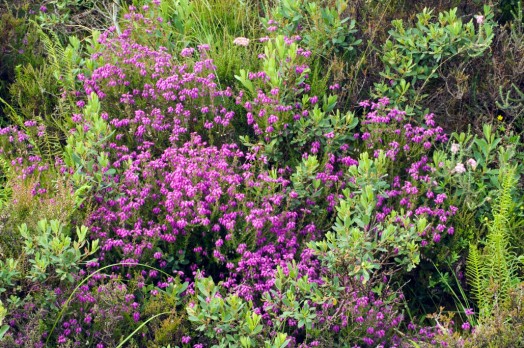
Heather – Credit: Lorne Gill – © Scottish Natural Heritage
Grazing impacts
Where a heather plant is ungrazed it produces annual shoots to create long stems and a small open bush.
When it is grazed it produces more side shoots and the bush becomes smaller and tighter, often interlocking with neighbouring plants to form a canopy.
Under heavy grazing where most of the shoots are grazed the stem becomes contorted and twisted as the only surviving shoots are inside or below the plant.
Under extreme grazing plants exist as single stem drumsticks, very tight, small topiary bushes, or the stems remain at ground level where annual shoots appear in summer before they are grazed-off every winter.
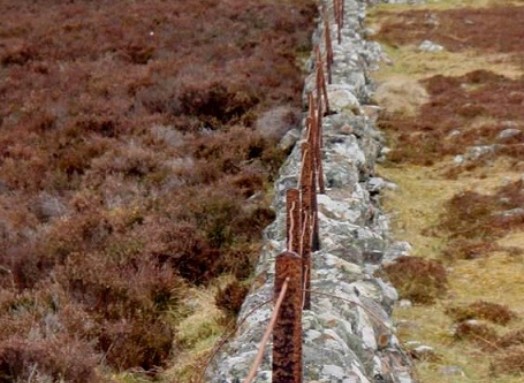
On the right side of the dyke the heather has been suppressed by grazing, and has been replaced by grassy patches – Credit: Graham Sullivan – © Scottish Natural Heritage
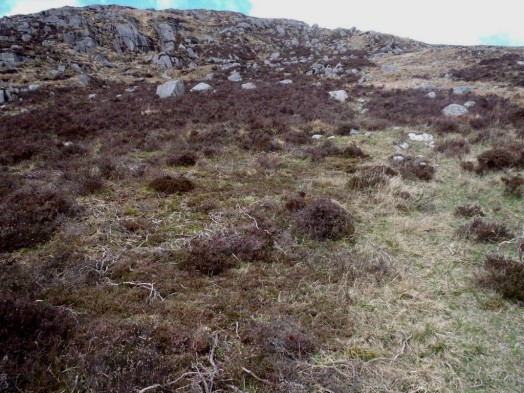
Heavy grazing around the edges of grass patches results in a ragged heather canopy and is suppressing young plants. Dead stems and 'topiary' plants can be seen. If this level of grazing continues heath will be replaced by grassland, as has happened on the right of the picture – Credit: Graham Sullivan – © Scottish Natural Heritage
What needs to be done?
Aim to keep dry heath in good, grazed condition with strong plants and minimal stem contortion. Large areas of dry heath typically support stocking rates of 0.5–1.5 ewes (0.075–0.22 lu) per hectare.
Higher stocking rates can be supported at low altitudes where satisfactory grasses form a significant proportion of the vegetation. In autumn and winter, stock numbers should be reduced by half.
Key points:
- grazing at suitable densities will help maintain dry heath in good condition
- heather is not heavily grazed when grass is available (unless grazing pressure is high)
- dry heath is most vulnerable in the winter
Wet heath
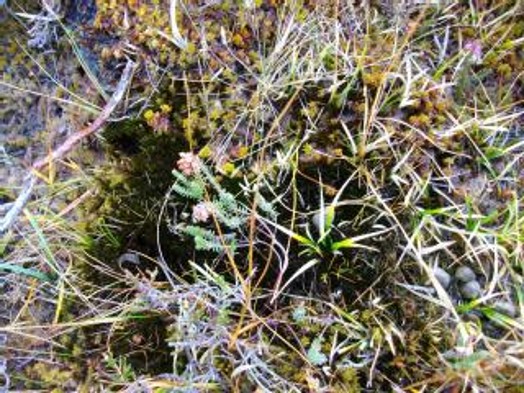
Wet heath – Credit: Mike Smedley – © Scottish Natural Heritage
What does it look like?
Vast areas of moorland consist of a habitat where a mix of weak heather and cross-leaved heath exists alongside purple moorgrass, usually on wet soil or peat.
Wet heath occurs on areas of thin wet peat (e.g. less than 50 centimetres), often on sloping ground.
The vegetation tends to be dominated by a mixture of dwarf-shrubs, sedges, grasses, mosses and lichens.
Heather will be less frequent than on dry heath and bog moss will be less common than on blanket bog.
Grazing impacts
The carrying capacity of this habitat is much lower than a dry heath and it takes longer to recover from grazing damage.
The wet nature of the soil also makes it vulnerable to trampling, particularly in the winter.
Where stock graze the heather during the winter it can be damaged to the point where it is replaced by purple moor grass which is of very low grazing or environmental value.
A useful way of assessing the grazing level is to look for grazed shoots of cross-leaved heath.
This species is extremely unpalatable and, when grazed, indicates very high grazing pressure and damage to other species.
What needs to be done?
Wet heaths typically support 0.25–0.5 ewes (0.037–0.075 lu) per hectare.
Reduce stocking density by at least half, and ideally remove all stock (especially cattle) in autumn and winter to benefit dwarf shrubs such as heather and to reduce the risk of trampling causing peat erosion.
Key points:
- supports low stocking densities
- vulnerable to grazing and trampling particularly in the winter
Blanket bog
What does it look like?
Large areas of peat can be covered by wet or dry heath or, where the water table is high, by bog habitats with abundant cotton grasses and sphagnum mosses.
Blanket bog usually occurs on areas of flat or gently sloping deep wet peat (e.g. greater than 50cm).
The vegetation tends to be dominated by a mixture of sphagnum mosses, sedges such as cotton grass, dwarf shrubs and, in certain areas, purple moor-grass and deer grass. Sphagnum moss is more common and forms continual carpets of moss.
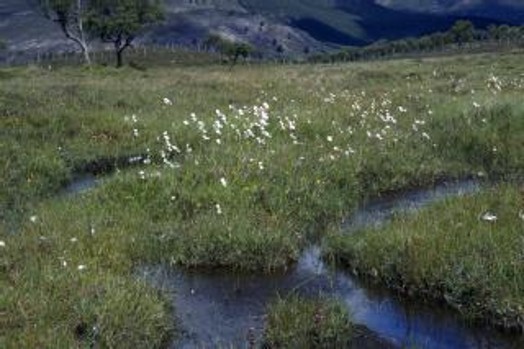
Bog vegetation – © Scottish Natural Heritage
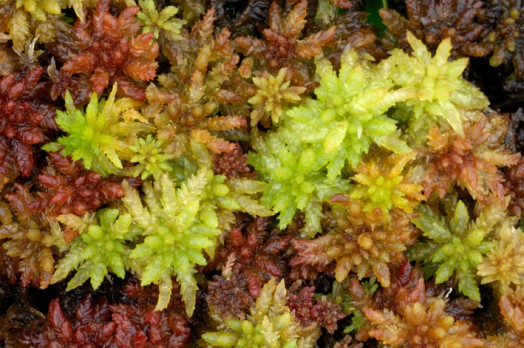
Sphagnum mosses – Credit: Lorne Gill – © Scottish Natural Heritage
Grazing impacts
On blanket bog, the aim is not only to keep the habitat in good condition, but to protect the peat below. Peat bogs traditionally carry very low stocking rates apart from a short period in the spring when sheep and deer look for cotton grass shoots.
The key to good management is to ensure that grazing and trampling pressure is low enough to avoid exposing any new peat and to allow some re-vegetation to occur where peat is being eroded.
Blanket bog has a low carrying capacity and is vulnerable to trampling and erosion from both stock and deer. As with wet heath, excess grazing pressure on heather (particularly during the winter) can lead to it being damaged to the point where it is replaced by purple moor-grass.
What needs to be done?
Blanket bog typically supports 0.25–0.5 sheep (0.037–0.075 lu) per hectare.
Reduce stocking density by at least half, and ideally remove all stock in autumn and winter to benefit dwarf shrubs such as heather and reduce the risk of trampling of peat causing erosion.
Where bog is already heavily impacted density may need to be below these levels to permit recovery, particularly where there is erosion.
A high water table is essential to the formation of new peat. Blocking of ditches can restore the peatland function where bogs have been drained in the past.
Avoid blanket bog areas if undertaking muirburn.
Key points:
- supports low stocking densities
- more vulnerable to trampling than grazing
Upland grasslands
What do they look like?
These habitats vary from grasslands dominated by the dense and rough purple moor grass and tufted hair grass to the very short swards of high altitude calcareous grasslands.
The dense, rough grasses usually dominate other species and in many cases this habitat can benefit from heavier grazing, particularly from cattle.
Good management should aim to encourage stock to consume more of these grasses while preserving more sensitive habitats.
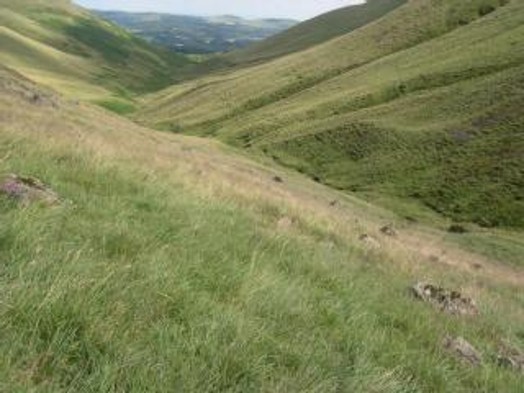
Calcareous grassland at Dollar Glen – Credit: Peter McPhail – © Scottish Natural Heritage
What needs to be done?
The short swards of herb-rich grasslands on well-drained slopes are the most productive of upland habitats and usually carry the heaviest stocking rates. They vary from acid to calcareous types depending on the underlying geology.
Good management here aims to allow the wide diversity of flowering plants in the sward to flower and set seed during the summer, but retains grazing at a level which ensures that grasses do not outcompete flowers.
This can be challenging as stock preferentially graze these grasslands and are always drawn to them. Good management can be achieved through an appropriate stocking rate or bespoke 'off-summering' arrangements. This habitat can suffer from undergrazing if too much of the summer's growth is left ungrazed.
Key points:
- habitat requires grazing
- more vulnerable to overgrazing in the summer
Other specialist habitats such as tall-herb communities and montane scrub are palatable and can be attractive to all herbivores. Preventing damage may necessitate enclosure to exclude stock and / or deer.
Other moorland management practices
Deer management
The number and seasonal movements of deer need to be taken into consideration when planning your moorland management.
Deer will reducethe forage available to domestic stock. It is importantnot only to assess their current impact on the habitats, but to estimate their response to your proposed management.
If you manage the deer on the holding, or you are applying only for deer management, include a deer management plan as part of your moorland management plan.
You can find information on annual cull deer returns and a link to the online recording system on the Scottish Natural Heritage website. Record in your diary the date you submit this return.
Further details on how to fill in a return are available on the Best Practice Guides website.
Muirburn
Burning heather, and in some cases grass, can be a useful management tool. By increasing grazing value it can be used to divert grazing from elsewhere as well as rejuvenating habitats.
Muirburn needs careful planning and control as if burning is too frequent, with large fires or in inappropriate locations such as peat bogs, it can damage the moorland habitat to the detriment of the agricultural and natural interests.
It is important to get the scale right. Too few areas and you create a focus for grazing on the new growth which is detrimental. Too much and you remove too much forage and cannot achieve a long-term rotation.
The muirburn code and its supplement should be followed. This code provides good advice on all aspects of muirburn and preparing your plan.
Supplementary feeding
Many hill sheep flocks and hill cows rely on supplementary feeding. This activity can have an influence on the habitats surrounding it and there are many considerations to make when planning it.
Gathering stock in one place to feed can cause localised trampling and erosion or enrichment of the vegetation.
Consideration should be given to the habitat you are feeding on – bogs and wet heaths are particularly susceptible to poaching and erosion.
Locate stock feeders on dry, hard ground where the soil is of mineral, rather than a peaty, nature and rotate feeding sites to avoid erosion. Feeding hay or silage can import seeds as well as nutrients, so consider the value of the habitat you are influencing.
Although feeding deer is not recommended by Scottish Natural Heritage, the same consideration should be given to this practice.
Vehicle use
The use of vehicles on existing tracks and within reseeded areas causes little or no damage to moorland habitats. Damage to habitats on moorland can be avoided by the use of low ground pressure vehicles and by varying the routes used.
Soft, wet ground and areas of fragile soils are the most sensitive, where the habitat could be damaged and expose the peat or soil to further erosion.
Peat cutting
Traditional cutting of peat by hand where the turf is replaced to regrow at the bottom of the bank can be sustainable in all but the most sensitive of peatlands. Further advice should be sought from Scottish Natural Heritage where this is part of your planned moorland activity.
Monitoring
The production of a moorland management plan requires an assessment of moorland condition. This should be based on a straightforward description of current habitat condition, but should also describe the desired condition and objectives.
Monitoring could then be put in place to measure the move towards the desired condition.
Simple objectives could cover a number of habitats and could involve assessing habitat condition at fixed points, fixed point photography, assessment of the number of flowering plants, grazing pressure on heather and trampling on mosses, and a range of other options.
For designated sites, Scottish Natural Heritage could be consulted for advice on monitoring methods.
For guidance on monitoring deer impacts see the protocol set out in the deer best practice guides.
